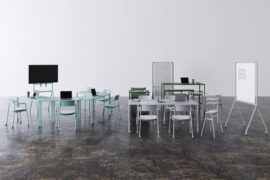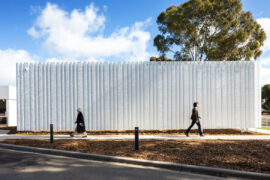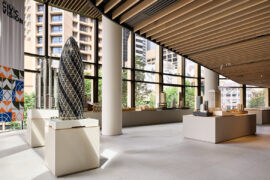The Finding Infinity Principal comments here on the question of balance in city life, with architecture and design highlighted as the key levers for making change.

June 13th, 2025
This article originally appeared in INDESIGN magazine – find out more and subscribe here!
Not every project has to solve a bigger problem for the city or have a purpose beyond serving that specific client, but imagine if they did. Imagine if every single project our industry worked on was aligned to a purpose of incrementally leaving the next generation with a self-sufficient city. A city based on infinite resources. A city that gives more than it takes. A city that is based on resources that will never run out.
When I was asked to write an article about work-life balance, I had a good laugh. I’m not entirely sure what work-life balance means. For me it’s all a blur. Work is life. Life is work. If someone gave me one billion dollars, I would wake up tomorrow and keep doing the same thing, though the cash could help accelerate the work we do.

Work-life balance is often explored on a personal level, the balance between working enough to survive and taking time to thrive. But what about the work-life balance of a city? The balance between profit and culture. And how can policy help us out here?
If the city was considered one interconnected system, how is the city’s work-life balance going? And does it need a balance, or could it simply thrive by working harder and harder by aligning with a purpose?
I’m obsessed with the idea that a city does not need to have a negative impact on the environment. And our role is enabling this to happen in our generation. Today, based on currently available, off-the-shelf technology and solutions, we can actually leave a positive city and profit from the transition.

When we consume finite resources, they leave us with finite by-products and those by-products create environmental degradation. For example, coal becomes carbon, or fresh water becomes sewer, or virgin materials become landfill. When we consume infinite resources, there is no by-product, or if we want to get into the nitty gritty, very little and less and less so. There is no perfect solution, but as we progress we can certainly get closer and closer to this ideal scenario.
This technology is super profitable, there is $100-billion of stuff out there ready for us to implement and make returns on today, in Melbourne alone. And the wild thing is, if we implemented all of this profitable stuff, we could transform from consumers to producers… The challenge we currently face is how to simply deploy the solutions fast enough to enable us all to thrive (and/or survive, depending on how you want to look at it).
Related: Lessons from Canberra’s planned history

From years of trial and error in this space I believe the intersection between technology and culture is where the magic happens. It’s a city-scaled work-life balance. But, they do not have to compete with each other like our work and our lives do on a personal level. They are extremely complementary. And, actually, bringing these solutions together with culture will help accelerate the transition.
Architecture is the vessel for this transformation. It is not finance or technology or policy that will enable this transformation. Architecture has an extremely important role in delivering this transformation. Architecture can bring technology and culture together to create deliverable projects that exemplify the policy we need. Architecture and design can be so very proactive in this process.
Long story short, we developed a strategy to transform Melbourne to become self-sufficient by 2030 and then turned it into 15 projects, eight of which got funded, $200-million worth of projects, three are now built and more are in the pipeline. And each of these projects integrate technology with culture.

Let me share some examples. There are one million homes out there that need to be electrified and retrofitted, we started with 15 studio apartments in Fitzroy with Kennedy Nolan. There are 40,000 commercial buildings in Greater Melbourne, we started with one with NMBW in Richmond. We need to build 150 organic energy plants across Melbourne, we are starting with one with Hassell in Cremorne. We need 1,000 water treatment plants decentralised across the city to provide the city with an unlimited supply of water. Let’s start with one. We need a Net Zero Code, let’s build an example of what it should be.
Every project has that moment when it can be business as usual; it also has a moment when it can step up and do something more, to give back to the city and future generations. It can be as simple as working on a small home extension and helping remove gas or adding solar. Or choosing to retain and repair instead of demolish. Or selecting low carbon, circular materials. Or it can be as large as transforming a neighbourhood. Every project, no matter how big or small, no matter the budget, is an opportunity to help transform our cities. Let’s get on with it.
Finding Infinity
findinginfinity.com
P.S. We have now set up a new normal in Melbourne and Sydney. Melbourne round two will be on exhibition at NGV Design Week this year. We are in the process of setting up in Perth and Also Guadalajara in Mexico.





Next up: Reconsidering the Brisbane Olympics with WilkinsonEyre
INDESIGN is on instagram
Follow @indesignlive
A searchable and comprehensive guide for specifying leading products and their suppliers
Keep up to date with the latest and greatest from our industry BFF's!

Welcomed to the Australian design scene in 2024, Kokuyo is set to redefine collaboration, bringing its unique blend of colour and function to individuals and corporations, designed to be used Any Way!

London-based design duo Raw Edges have joined forces with Established & Sons and Tongue & Groove to introduce Wall to Wall – a hand-stained, “living collection” that transforms parquet flooring into a canvas of colour, pattern, and possibility.

Through expert architecture, EBD Architects has provided a human face to great design and created a project that enhances the lives of people and community.

Neill Johanson, Principal at Davenport Campbell, comments on what we might be losing and gaining with the expansion of remote work.
The internet never sleeps! Here's the stuff you might have missed

Smart Design Studio and Those Architects combine landmark and workplace in Bundarra, a Surry Hills gateway blending old and new.

Civic Vision, a major exhibition showcasing the global work of Foster + Partners, has officially opened in Sydney.